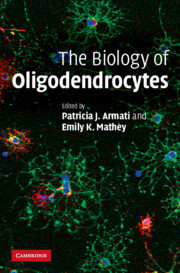Book contents
- Frontmatter
- Contents
- Preface
- Contributors
- 1 CNS oligarchs; the rise of the oligodendrocyte in a neuron-centric culture
- 2 Comparative biology of Schwann cells and oligodendrocytes
- 3 Control of oligodendrocyte development and myelination in the vertebrate CNS
- 4 Molecular organization of the oligodendrocyte and myelin
- 5 The genetics of oligodendrocytes
- 6 Immunobiology of the oligodendrocyte
- 7 Oligodendrocytes and disease: repair, remyelination and stem cells
- 8 Glial progenitor cells and the dynamics of the oligodendrocyte and its myelin in the aged and injured CNS
- 9 Oligodendroglial pathology in multiple sclerosis
- 10 Glutamate receptors, transporters and periventricular leukomalacia
- References
- Index
- Plate section
5 - The genetics of oligodendrocytes
Published online by Cambridge University Press: 05 August 2012
- Frontmatter
- Contents
- Preface
- Contributors
- 1 CNS oligarchs; the rise of the oligodendrocyte in a neuron-centric culture
- 2 Comparative biology of Schwann cells and oligodendrocytes
- 3 Control of oligodendrocyte development and myelination in the vertebrate CNS
- 4 Molecular organization of the oligodendrocyte and myelin
- 5 The genetics of oligodendrocytes
- 6 Immunobiology of the oligodendrocyte
- 7 Oligodendrocytes and disease: repair, remyelination and stem cells
- 8 Glial progenitor cells and the dynamics of the oligodendrocyte and its myelin in the aged and injured CNS
- 9 Oligodendroglial pathology in multiple sclerosis
- 10 Glutamate receptors, transporters and periventricular leukomalacia
- References
- Index
- Plate section
Summary
INTRODUCTION
Over the past decade, there has been tremendous progress in our understanding of oligodendrocyte biology. Many of the factors that are important for the specification of oligodendrocytes during development have been identified (Kessaris et al., 2008). In addition, the emergence of genomic technologies has greatly improved our understanding of the factors that affect oligodendrocytes during development and in disease. In this chapter, we highlight some of the significant discoveries that have advanced our understanding of the genetic factors that are important in oligodendrocytes, and we identify some of the contributions that were made to this field using genomic technologies.
OLIGODENDROCYTE SPECIFICATION
A great deal of progress has been made in understanding the earliest events of oligodendrocyte specification. The spinal cord has received the most attention, and soluble signaling molecules such as sonic hedgehog (Shh) (Cai et al., 2005) and bone morphogenic proteins (BMPs) are key early regulators of oligodendrocyte development in this part of the central nervous system (CNS). Shh is secreted from the ventral floor plate and is required for the specification of oligodendrocytes (Orentas et al., 1999). Shh signaling induces the expression of the basic helix-loop-helix (bHLH) transcription factors Olig1 and Olig2 in a region of the ventral spinal cord referred to as the motor neuron progenitor (pMN) domain (Lu et al., 2000; Zhou et al., 2000). Shh and Olig gene expression is required for oligodendrocyte specification in the spinal cord and brain (Zhou and Anderson, 2002).
- Type
- Chapter
- Information
- The Biology of Oligodendrocytes , pp. 103 - 114Publisher: Cambridge University PressPrint publication year: 2010



